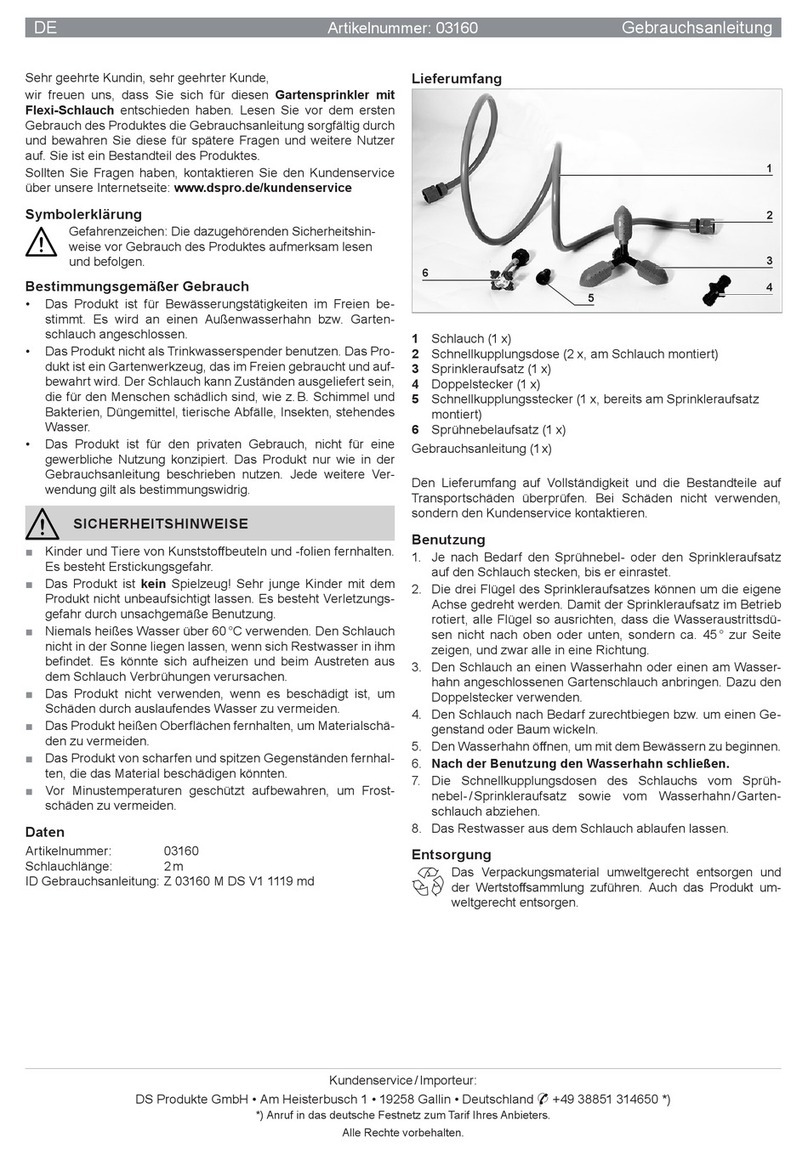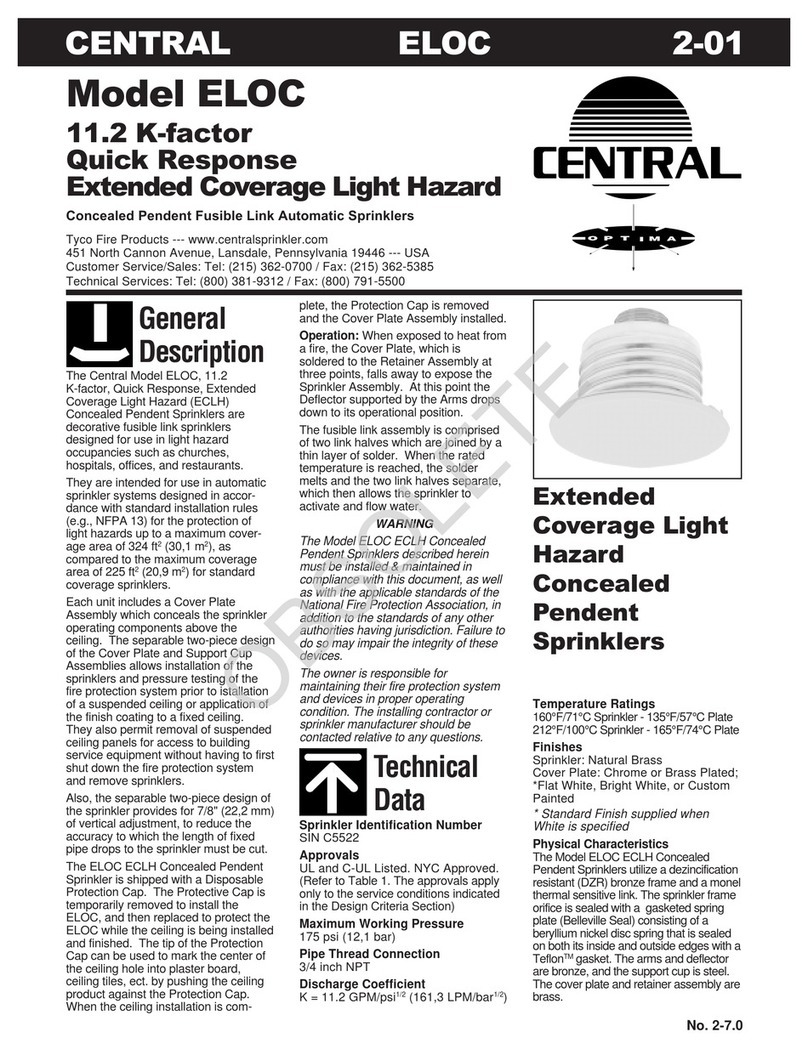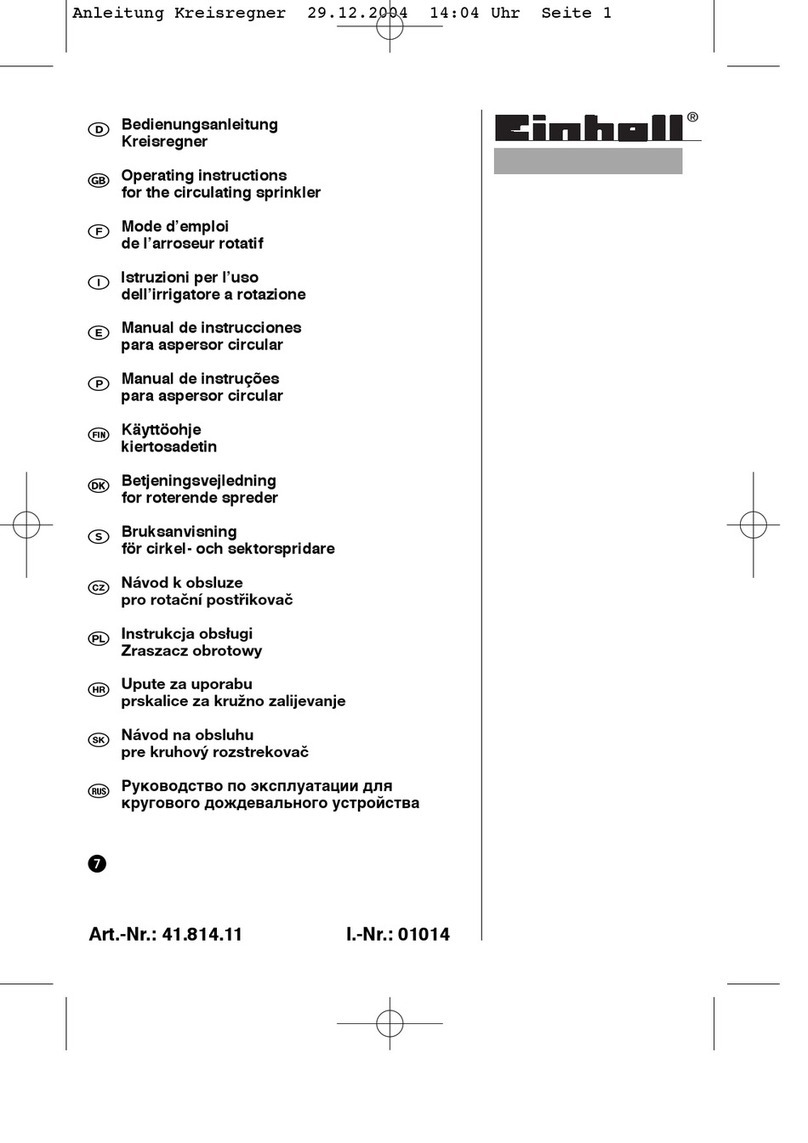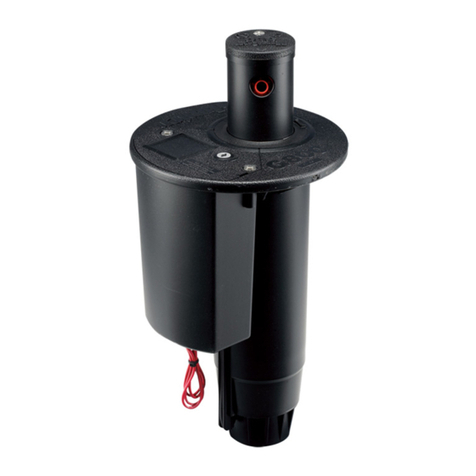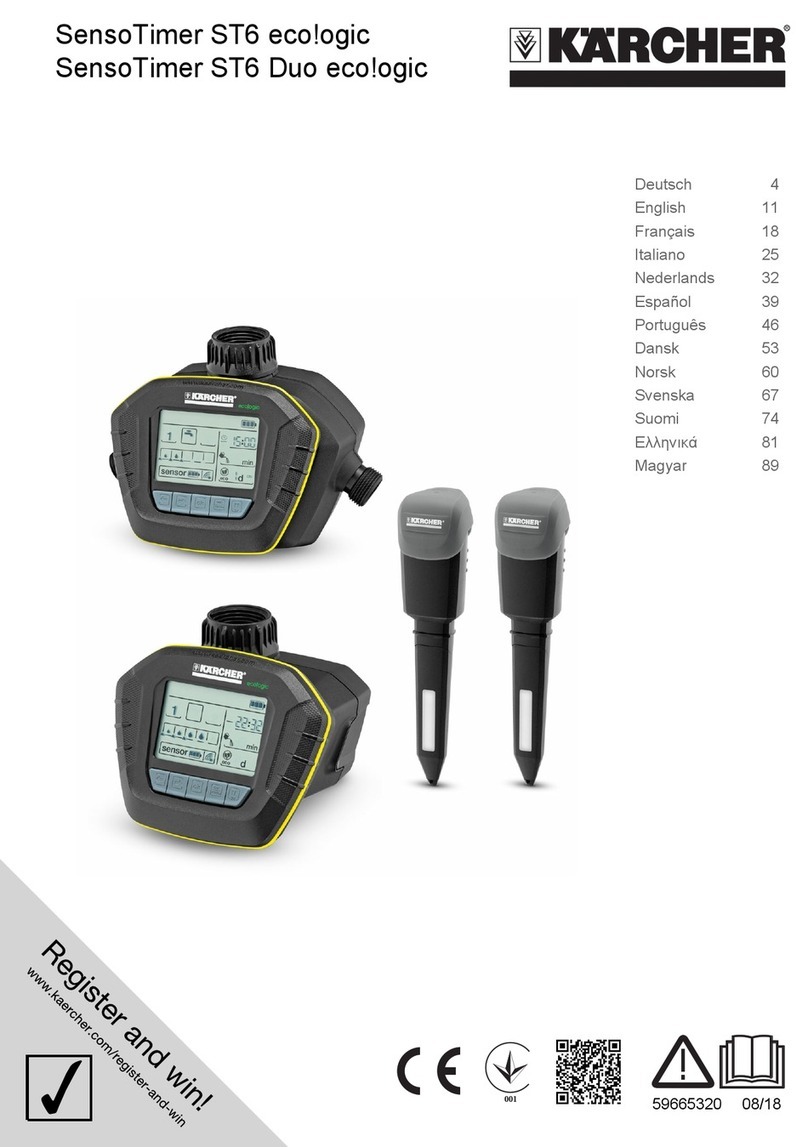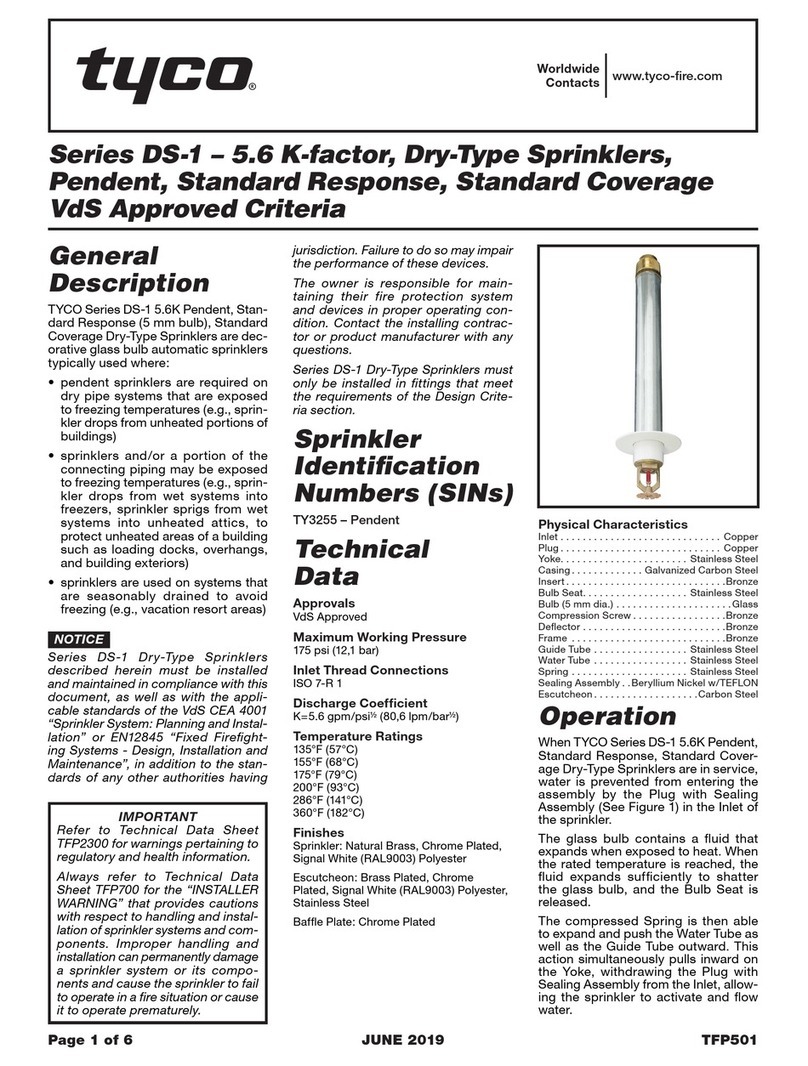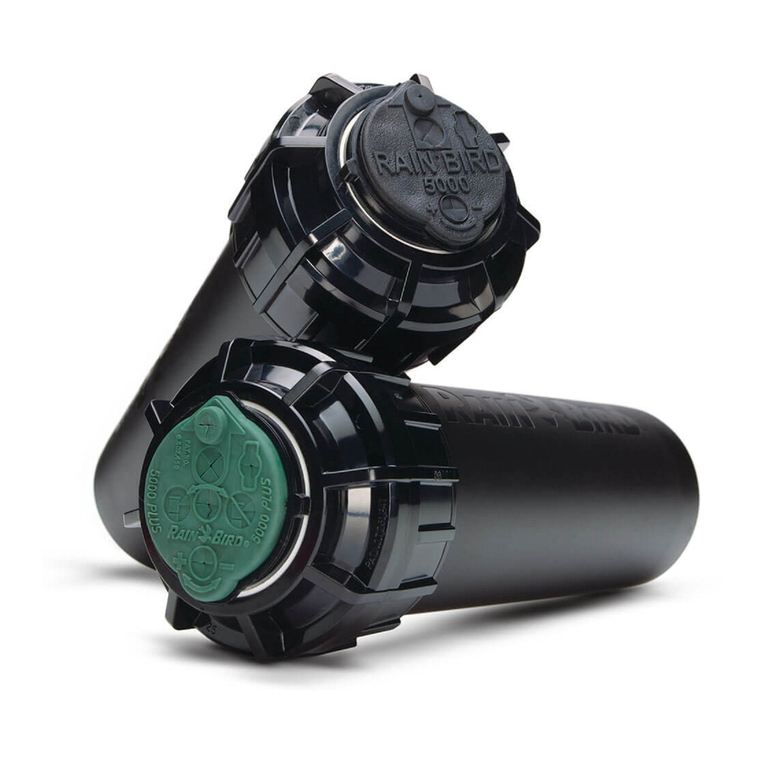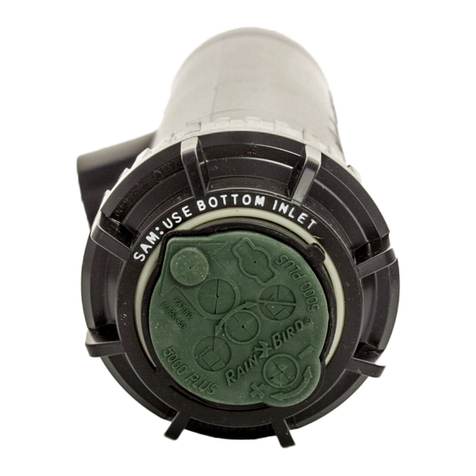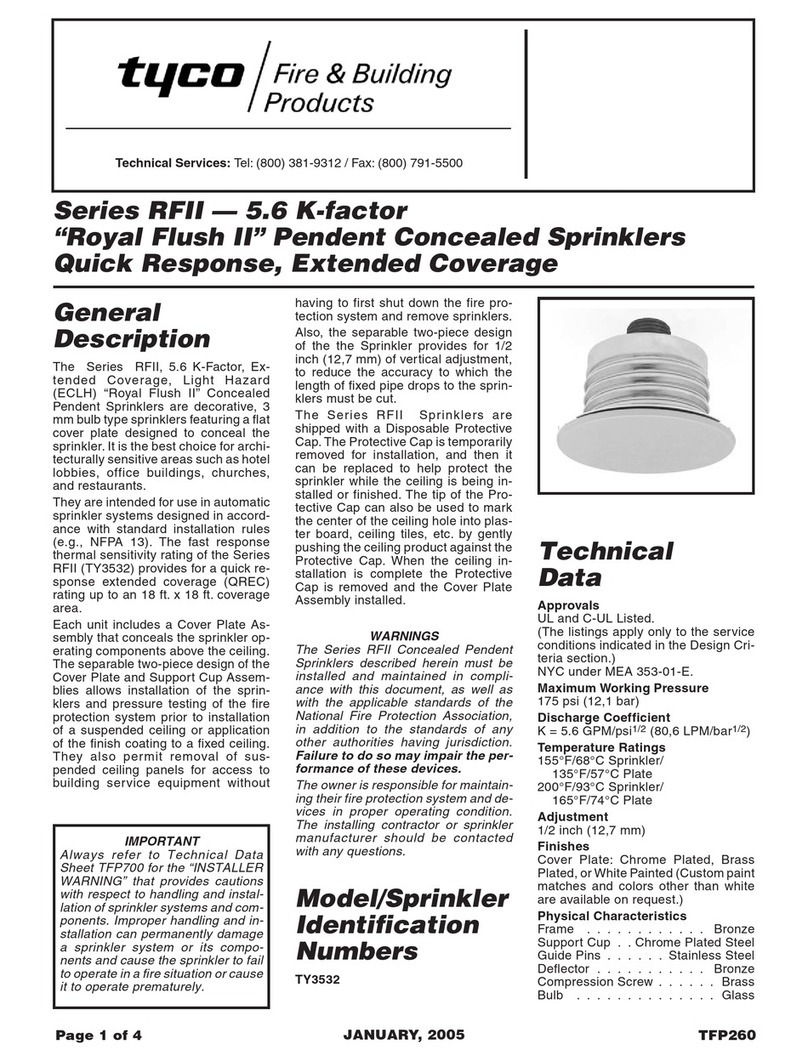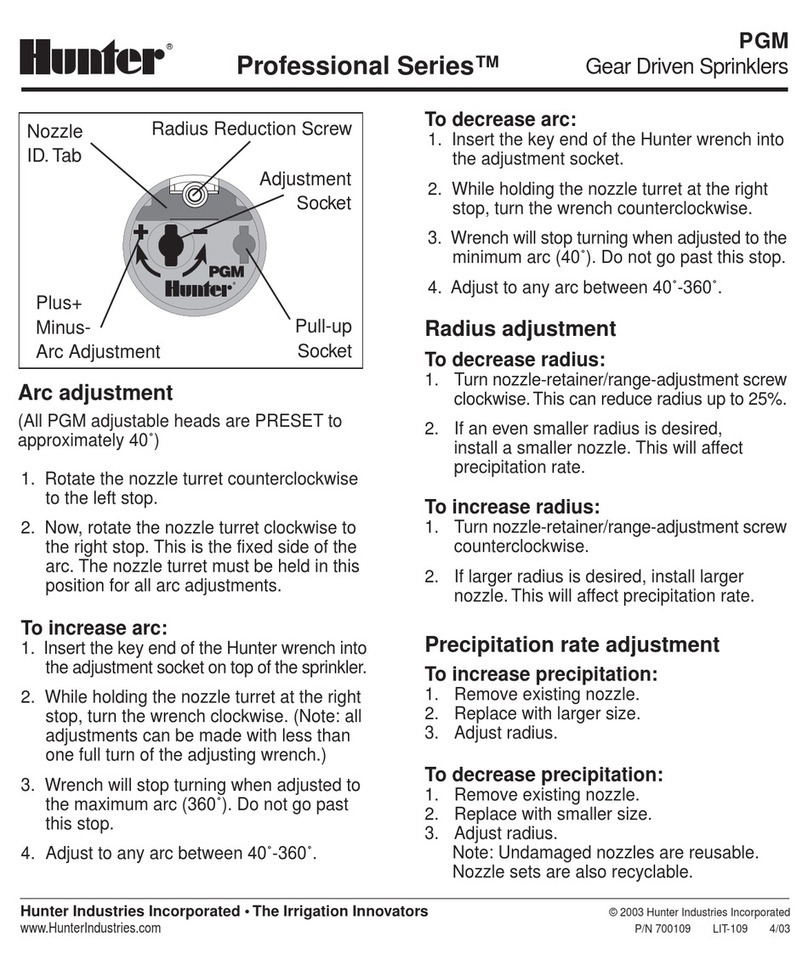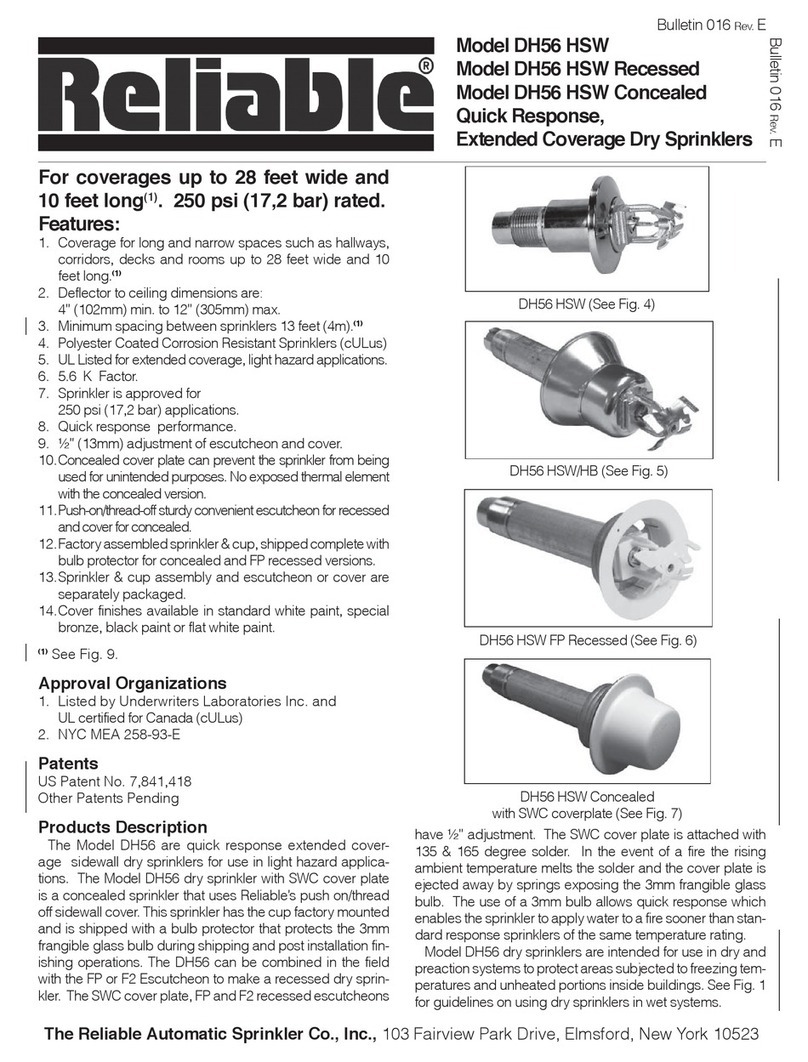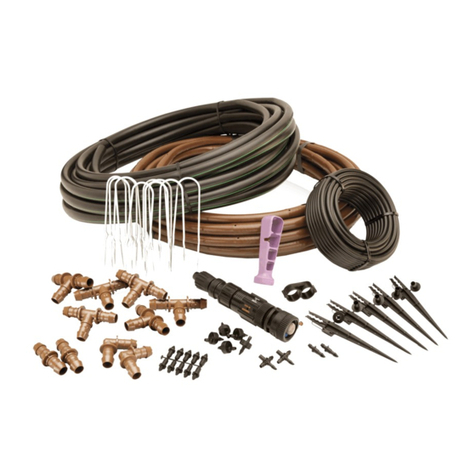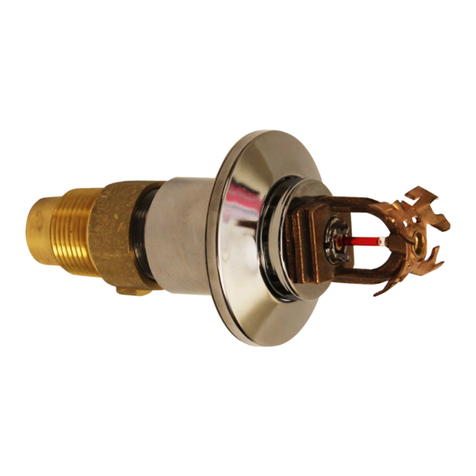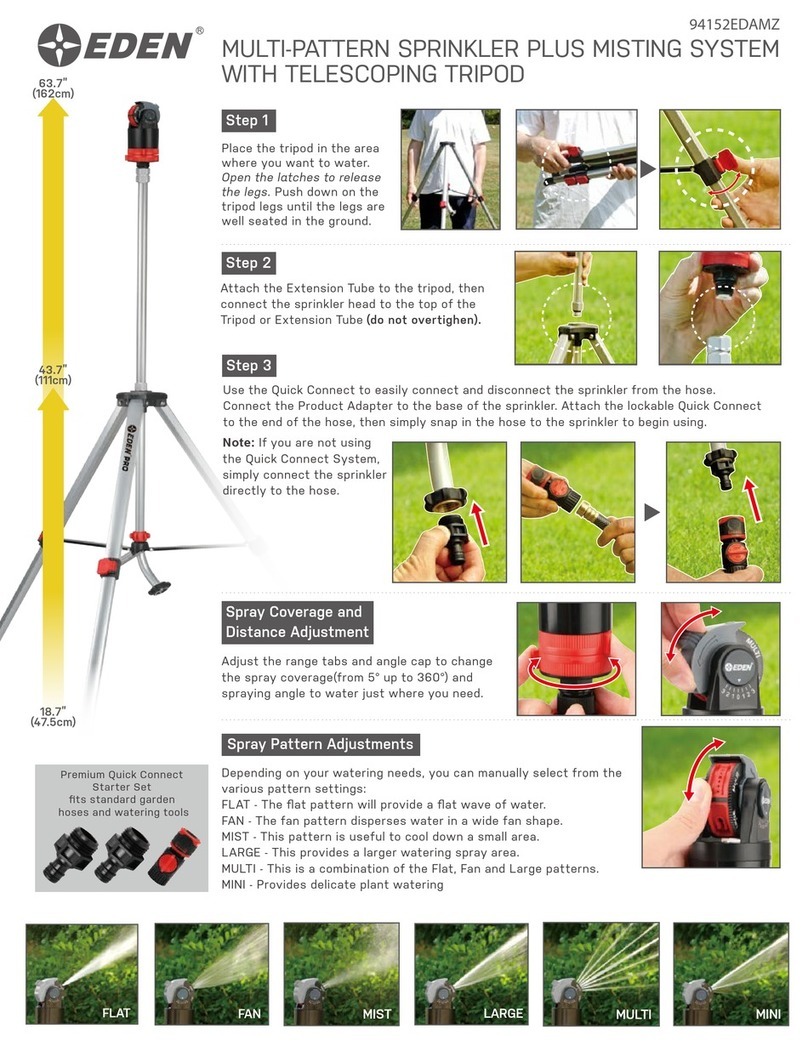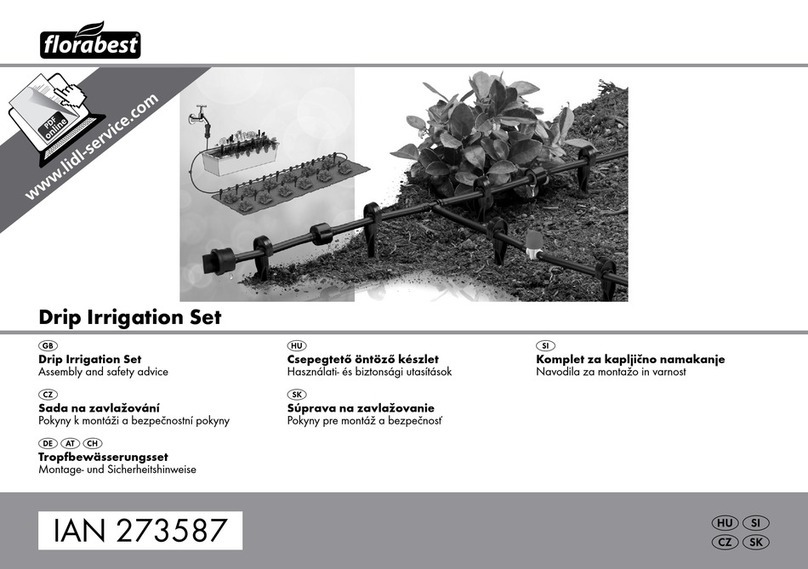General Air Products Vapor Pipe Shield VPS-500A User manual

Vapor Pipe Shield™
ENGINEERED VAPOR-PHASE CORROSION INHIBITOR SYSTEMS
For Dry Pipe & Pre-Action Fire Sprinkler Systems
Installation, Operation, and
Maintenance Manual
Models: VPS-500A / VPS-1000A / VPS-1500A / VPS-2000A
Version 1.8
Dec.-2022
Technical Assistance:
800-345-8207
Additional Product Information:
generalairproducts.com

Version 1.8
Dec.-2022
Page | 2
Call
1-800-345-8207
or visit our web site for our complete product listing
www.GeneralAirProducts.com
TABLE OF CONTENTS
1 Safety Guidelines & Disclosures.......................................................................................................................................................... 3
2 Overview.................................................................................................................................................................................................. 4
3 Installation ................................................................................................................................................................................................ 5
3.1 Location...........................................................................................................................................................................................5
3.2 Mounting..........................................................................................................................................................................................6
3.3 Flow Reversal (Field Retrofit).....................................................................................................................................................9
3.4 Inlet Connections........................................................................................................................................................................10
3.5 Outlet Connections....................................................................................................................................................................10
3.6 Drain Connections......................................................................................................................................................................11
3.7 VPS Purge Valve...........................................................................................................................................................................12
3.8 VPS Vapor Indicator Test-Port ................................................................................................................................................15
3.9 Material Compatibility................................................................................................................................................................16
3.10 Illustrative Layout........................................................................................................................................................................16
4 Start-Up Instructions ..........................................................................................................................................................................17
5 Theory of Operation ...........................................................................................................................................................................19
5.1 Initial Filtration (Pre-filters).......................................................................................................................................................19
5.2 Proprietary Air Treatment (Module(s) & Cartridge(s)).....................................................................................................19
5.3 Post Filtration (After-filter).......................................................................................................................................................19
5.4 Protection Dispersal Through the Dry-Pipe Sprinkler System ........................................................................................19
6 Maintenance Schedule .........................................................................................................................................................................20
6.1 Standard Maintenance Procedure (annual) ...........................................................................................................................20
7 Troubleshooting....................................................................................................................................................................................25
8 General Arrangements........................................................................................................................................................................26
8.1 Sample System Layout................................................................................................................................................................26
8.2 Feature Layout .............................................................................................................................................................................26
8.3 Maintenance Schedule Connections .......................................................................................................................................27
8.4 Module/ Cartridge Arrangement.............................................................................................................................................28
8.5 General Arrangement ................................................................................................................................................................29
9 Warranty Policy....................................................................................................................................................................................30
IMPORTANT: ALL INFORMATION SUBJECT TO CHANGE WITHOUT NOTICE.
Consult factory for the most up to date version of this manual - 1-800-345-8207.

Version 1.8
Dec.-2022
Page | 3
1SAFETY GUIDELINES &DISCLOSURES
This manual contains information that is very important to know and understand. This information is
provided for SAFETY and to PREVENT EQUIPMENT PROBLEMS. To help recognize this information, observe
the following symbols.
Danger indicates an imminently hazardous situation which, if not avoided, WILL
result in death or serious injury.
Warning indicates a potentially hazardous situation which, if not avoided COULD
result in death or serious injury.
Caution indicates a potentially hazardous situation which, if not avoided, MAY result
in minor or moderate injury.
Notice indicates important information, that if not followed may cause damage to
equipment
GENERAL SAFETY STATEMENTS
Always wear proper PPE suitable to the work being done when handling or operating Vapor Pipe Shield (VPS)
in your unique environment. Use of VPS shall be in conformance with all applicable health and environmental
regulations for the location where it is installed. A material safety datasheet is available on the manufacturer’s
website for additional health and safety information: www.generalairproducts.com.
In the event of sprinkler head activation, exit the building per standard fire procedures for the building in
accordance with state and local guidelines.
VPS (when properly sized) is intended to provide corrosion protection for a Dry or Pre-Action Fire-Sprinkler
System for one year before replenishment is required. VPS is not compatible with other types of fire-sprinkler
systems. VPS is intended for use where the ambient conditions of the sprinkler piping range between -40ºF and
150ºF. The VPS module itself must be installed in an ambient temperature between +40°F and 150°F.
Contaminants or other foreign materials within a sprinkler system may adversely impact the properties and
performance of the vapor corrosion inhibitor. The functional life of VPS may be impacted by the end-use
environmental conditions. Systems using VPS are to be inspected, tested, and maintained in accordance with the
manufacturer’s instructions and NFPA 25. Any air compressor(s) in use with VPS must utilize a pressure relief
valve on or adjacent to the compressor, and the pressure-relief set pressure must be less than the pressure
rating of the VPS unit. System fill time must be checked for compliance with NFPA standards after installation.
For more information, contact General Air Products Technical Assistance at (800) 345-8207 for assistance
as needed.
DANGER
WARNING
CAUTION
NOTICE

Version 1.8
Dec.-2022
Page | 4
2OVERVIEW
Vapor Pipe Shield (VPS) was created to be an economical & scalable option to protect various sizes of
dry-pipe sprinkler systems, and is easily upgradable to handle later-date expansions of existing systems. Sizing
and capacity information for VPS variants are displayed in the table below.
Model
System
Installed
Overall Dimensions
Approximate
Number
Capacity*
Cartridges
(L x W x H)
Weight
VPS-500A
500 Gallon
1
6.5” x 28.75” x 20.25”
20 Lbs.
VPS-1000A
1,000 Gallon
2
6.5” x 28.75” x 28.25”
26 Lbs.
VPS-1500A
1,500 Gallon
3
6.5” x 28.75” x 36.25”
32 Lbs.
VPS-2000A
2,000 Gallon
4
6.5” x 28.75” x 44.25”
38 Lbs.
* System capacity is +/- 10% due to site location and conditions.
VPS is positioned after both the Air Source (air compressor) (sold separately) & Check Valve
(immediately off the air source) (sold separately), but before any Air Maintenance Device (sold separately) if
one or more is installed. Air from the air source enters the VPS unit and goes through the 3-phase process
described below.
Following the air treatment, protection-infused air exits the VPS unit and is directed into any Air
Maintenance Device (or directly into the piping system if no AMD is utilized), and from there into the dry-pipe
sprinkler system to be protected. Purging the dry-pipe sprinkler system of air is not required; however, in
some cases it is desirable to bleed air from the system in order to disperse the VPS vapors throughout the
piping system as quickly as possible. A Purge Valve (sold separately) (positioned near the Inspector’s Test Port),
is available to boost protection-infused air distribution throughout the system. The expected time for inhibitor
coverage with no purge is 21 days or less, or 10 days or less if a purge valve is utilized. At the end of 21 or 10
days per the above, the system gains protection and the Purge Valve (if utilized) can be shut off. A simplified
representation of VPS installed on a system is shown below.
Initial Filtration
•Bulk-Water Removal
•2-stage Coalescing Filtration
(down to 0.01 micron)
Propriatary Treatment
•Air Infused with protective
elements
Post Filtration & Valve
•Additional water (condensate)
removal
•Isolation valve

Version 1.8
Dec.-2022
Page | 5
Vapor Pipe Shield is intended for the exclusive use with properly-sized General Air Products’Fire-
Protection Air Compressors. Use with alternative equipment may not have been verified by the Manufacturer
and may void Manufacturer’s Warranty.
3INSTALLATION
3.1 LOCATION
Install the Vapor Pipe Shield (VPS) unit in a clean, dry location; with ambient temperatures between 40°
F (4.5º C) and 150º F (65.5º C) at all times; adjacent to the system piping.
When installing, be sure to allow ample room to access and maintain all forward-facing components,
namely the Filters (to change the filter elements) and the Module(s) (to change Cartridge(s)). It is recommended
that a minimum of 3 inches clearance off the left & right, and 6 inches clearance off the top & bottom
be provided for the VPS unit. Recommended minimum clearances are shown below.
The unit must be connected in-line with the dry-pipe sprinkler system. The main module unit must be
mounted vertically as shown above, so that all Drain Ports are facing down. Additional space below the VPS
unit for collection containers may be required, in addition to the 6” clearance from the bottom of the unit.
If the location is subject to excessive humidity, additional water removal devices may
be necessary to install between the air source/ air storage tank and the VPS unit.
For more information and/ or options for water removal, contact General Air Products
Technical Assistance at (800) 345-8207.
NOTICE

Version 1.8
Dec.-2022
Page | 6
If the mounting location is below freezing at any time, the system may be damaged
which COULD result in death or serious injury. All components under pressure must
be inspected immediately before use.
The unit must be positioned after both the Air Source (air compressor) (sold separately) & Check Valve
(immediately off the air source) (sold separately), but before any Air Maintenance Device (sold separately). It
is recommended to install an isolatable bypass around the unit for more convenient maintenance. Do NOT
flood the VPS unit with water. Flooding the unit will require ALL cartridges to be replaced. While the VPS
unit is designed to operate as a standalone corrosion mitigation device, the unit may also be used in conjunction
with other types of corrosion mitigation equipment, such as but not limited to: Dryers, Nitrogen Generators,
etc.; confirm suitability with your manufacturer. In such a case(s), the unit should be installed after such
equipment, and a Shutoff Valve (sold separately) is strongly recommended to be placed before the VPS unit.
Contact General Air Products Technical Assistance at (800) 345-8207 for assistance as needed.
If the VPS unit is to be placed before the other corrosion mitigation equipment,
contact the corrosion mitigation equipment’s manufacturer first to confirm such
positioning is compatible with their unit.
Do not puncture the VPS unit; or attempt to install, service, or change a Cartridge;
or attempt to loosen any fittings on the VPS unit while under pressure. Doing so
COULD result in death or serious injury. All components under pressure must be
inspected before use.
3.2 MOUNTING
Mount the VPS unit to a wall or stable structure using ¼ inch hardware (not included) that is
appropriate for the mounting surface. The upper mounting clamp (located on the top-most Module) and the
two main brackets (located on the second & last filter) are used to support the VPS unit. Do not clamp over
or mount on the filter bowls, as they will need to be accessed during maintenance periods. Acceptable mounting
locations on the VPS unit are displayed below.
WARNING
NOTICE
WARNING

Version 1.8
Dec.-2022
Page | 7
While the VPS unit creates no vibration, failure to properly secure the unit may result
in damage to the system, unit, or personnel.
CAUTION

Version 1.8
Dec.-2022
Page | 8
1) Mount Upper Clamp.
2) Push the top-most Module of the VPS unit
into the Upper Clamp as shown. The jaws
of the Upper Clamp should lock completely
over the top-most Module. Note, the top-
most Module will rest loosely inside the
Upper Clamp.
3) Lift the VPS unit slightly so that the weight
is off the Upper Clamp. Then mount the
Mounting Brackets.
Failure to secure all clamps as
described may result in damage to
the system, unit, or personnel.
Additional measures may be required
to safely secure and mount the VPS
Unit depending on each situation.
NOTICE
CAUTION

Version 1.8
Dec.-2022
Page | 9
3.3 FLOW REVERSAL (FIELD RETROFIT)
The Vapor Pipe Shield (VPS) unit can have its
flow reversed by completing the following steps. If
already installed, always uninstall the VPS unit prior to
any field retrofit work. The standard configuration is
shown in the adjacent figure.
1) Remove the Filter Bowls by removing the
screws (4 each) located on the top of each
filter using a 4mm hex key; and remove the
Mounting Brackets by removing the screws (2
each) located on the top of each filter using a
5mm hex key. See adjacent figures.
2) Rotate the Filter Bowls 180º and reinstall them
using their respective mounting screws (4
each), using a 4mm hex key; and reinstall the
Mounting Brackets on the opposite set of
mounting holes on the same filters using their
respective screws (2 each), using a 5mm hex
key. Use Thread Locker on the mounting
bracket screws only. Ensure all O-rings /
Gaskets are in place, prior to reassembling.
See adjacent figure.

Version 1.8
Dec.-2022
Page | 10
3.4 INLET CONNECTIONS
The VPS inlet includes a water removal filter, followed by 2 coalescing filters, mounted in series on the
lower corner of the unit. The inlet of the first filter is to be connected to the air source/ air storage tank. It’s
strongly recommended that a Shutoff Valve (sold separately) be positioned directly before the VPS unit (between
the air source/ air storage tank and the VPS unit). See arrangement below. The inlet connection is ½” FNPT.
3.5 OUTLET CONNECTIONS
The VPS outlet includes a water removal filter, mounted on the lower corner of the unit, opposite from
the inlet filters. The outlet of this filter is connected to a Shutoff Valve. This valve should be connected to the
Air Maintenance Device (sold separately) or directly to the dry-pipe sprinkler system to be protected. See
arrangement below. The outlet connection is ½” FNPT.

Version 1.8
Dec.-2022
Page | 11
3.6 DRAIN CONNECTIONS
The VPS unit incorporates a built-in auto drain on each filter. These auto drains utilize 3/8” push to
connect tube fittings, which are available for routing the drains to a desired location. A coil of 3/8” tubing is
provided to connect to each Drain Port. Routing should be done vertically down from the unit. Avoid having
horizontal or uphill sections in the drain-lines, as dirt or debris could become lodged, which may in turn cause
blockage in the tubing. See arrangement below.

Version 1.8
Dec.-2022
Page | 12
3.7 VPS PURGE VALVE
Purging of fire sprinkler piping system is optional with VPS. The corrosion inhibitor vapors will
disperse throughout the piping system even without the aid of a purge valve. The initial filling of the sprinkler system
piping to normal working pressure provides sufficient VPS Inhibitor to provide complete corrosion protection
coverage to internal surfaces within approximately 21 days. Utilization of a purge valve reduces the time to achieve
coverage to approximately 10 days.
A VPS Purge Valve (sold separately), if utilized, should be installed at the end of the system, near the
Inspector’s Test Port – meeting the following location requirements:
❖Air released from the Purge Valve can be expelled to the outdoors with pipe or tubing; or simply locate
the purge valve outdoors.
❖If air from the Purge Valve is released indoors, the Purge Valve must be located in a well-ventilated, non-
occupied space. Air released from the purge valve must not be discharged into an occupied space.
In addition, any adjoining spaces to the Purge Valve’s location must be non-occupied.
❖Temporary presence in the non-occupied space shall not be more than 10 minutes.
❖24 hours after the purge process is complete, the space can be occupied
Purge Valves are available in both Manual and Automatic-Timer forms. The manual purge valve is
described in this manual. Consult the Automatic Timed purge valve installation and operation manual for
operating instructions.

Version 1.8
Dec.-2022
Page | 13
The VPS Purge Valve (optional) (sold separately), if utilized, must be set to the appropriate setting based
on the table below. Select the maximum pressure the dry-pipe sprinkler system will be operating on, then the
compressor flow rate. Where that column and row intersect on the chart is the numbered setting that the
VPS Purge Valve should be set to.
Example: For a LT29050A compressor with a max system pressure set to 50PSI, the appropriate purge setting would be 5.
(1.25 - 2.75 CFM) (2.75 - 3.75 CFM) (3.75 - 5 CFM) (5 - 7.75 CFM)
OLR12016AC OL25033AC LT425100A-HP LT425100A LT620100A LT2500500A-HP
L20033A L29050A L36575A L425100A L1220200A LT2500500B
L20033B L29050B L36575B L425100B L1220200B LT2500500B-HP
LT20033A LT29050A LT36575A LT425100B L1300300A LT620100A-HP
LT20033A-HP LT29050B LT36575B OL430100BC-HP L1300300B LT620100B
LT20033B-HP OL25033ACT LT425100B-HP OL430100BCT-HP L1600300A LT620100B-HP
LT29050A-HP OL55033AC-LP OL36550AC OL43075AC L1600300B LT900150A
LT29050B-HP OLR25033AC OL36550ACT OL43075ACT L2000500A LT900150A-HP
OL12516AC OLR25033AC-HP OL36550BC OL43075BC L2000500B LT900150B
OL12516ACT OLR55033AC-LP OL36550BCT OL43075BCT L2500500A LT900150B-HP
OL32016AC-LP OLT25033AC OL36575BC-HP OL550100BC-HP L2500500B OL1100200BC-HP
OLR32016AC-LP OLT25033AC-HP OL36575BCT-HP OL550100BCT-HP L620100A OL1100200BCT-HP
OLT12016AC OL86050AC-LP OL615100AC L620100B OL1225200AC
QL13525AC OLR40050AC OL615100ACT L900150A OL1225200ACT
QL13525ACT OLR40050AC-HP OL615100BC L900150B OL1225200BC
QL25050AC OLT40050AC OL615100BCT LT1220200A OL1225200BCT
QL25050ACT OLT40050AC-HP OL99075AC-LP LT1220200B OL915150AC
QL28025AC-LP OLR50075AC LT1300300A OL915150ACT
QL53050AC-LP OLR50075AC-HP LT1300300A-HP OL915150BC-HP
OLR600100AC LT1300300B OL915150BCT
OLR600100AC-HP LT1300300B-HP OL915150BCT-HP
OLR86050AC-LP LT1600300A OLR1100200AC-HP
OLR99075AC-LP LT1600300A-HP OLR1225200AC
OLT50075AC LT1600300B OLR915150AC
OLT50075AC-HP LT1600300B-HP OLR915150AC-HP
OLT600100AC LT2000500A OLR915150BC
OLT600100AC-HP LT2000500A-HP OLT1100200AC-HP
QL500100AC LT2000500B OLT1225200AC
QL500100ACT LT2000500B-HP OLT915150AC
LT2500500A OLT915150AC-HP
Compressor Output
(1.25 - 2.75 CFM)
Compressor Output
(2.75 - 3.75 CFM)
Compressor Output
(3.75 - 5 CFM)
Compressor Output
(5 - 7.75 CFM)
10 PSI 6 8 8 8
15 PSI 6 7 7 8
20 PSI 5 6 7 7
25 PSI 5 6 6 7
30 PSI 5 6 6 6
35 PSI 4 5 6 6
40 PSI 4 5 5 6
45 PSI 4 5 5 5
50 PSI 4 5 5 5
55 PSI 4 5 5 5
60 PSI 4 4 5 5
65 PSI 4 4 4 5
COMPRESSOR SIZE
8
8
8
7
7
7
6
6
6
5
GAP COMPRESSORS
(7.75 CFM +)
↓ ↓ ↓ PURGE VALVE SETTING ↓ ↓ ↓
Compressor Output
(7.75 CFM +)
System Pressure
5
5

Version 1.8
Dec.-2022
Page | 14
To adjust the Purge Setting, pull up lightly on the light-grey knob, and then turn in the +/-
direction to adjust the numbered setting as shown below. One full turn will increase the numbered
setting by one in either direction. Once set, lightly press the light-grey knob back in until it clicks back
into place. If the compressor runs more often than once every 15 minutes, dial the purge setting back
until the run rate falls between once every 15 –45 minutes.

Version 1.8
Dec.-2022
Page | 15
3.8 VPS VAPOR INDICATOR TEST-PORT
A VPS Vapor Indicator Test-Port (VIT) (included & optional) may be installed if desired. Also included
are a set of Replaceable Indicator Cartridges (RIC) (included & optional) which may also be used if desired on
the VIT. Further details described below.

Version 1.8
Dec.-2022
Page | 16
3.9 MATERIAL COMPATIBILITY
The following materials have undergone testing to confirm compatibility with the Vapor Pipe Shield Product. Materials
not shown may not have been verified by the manufacturer and may void warranty.
Contact General Air Products Technical Assistance at (800) 345-8207 for more information in regards to
material compatibility.
3.10 ILLUSTRATIVE LAYOUT
The basic setup of the VPS unit is displayed below.
Metals
•Brass
•Bronze
•Copper
•Cast Iron
•Steel
•Black Steel
•Stainless Steel
Elastomers
•Butyl Rubber
•EPDM
•Natural Rubber
•Nitril Rubber (BUNA-N)
•Styrene-Butadiene Rubber (SBR)

Version 1.8
Dec.-2022
Page | 17
4START-UP INSTRUCTIONS
With all the connections made as described in “SECTION 3; INSTALLATION –(PG.5)”, the Vapor Pipe Shield
(VPS) unit is ready to start. The following measures should be undertaken anytime a VPS unit is installed.
1) Depressurize the entire dry-pipe sprinkler system to atmosphere (0 PSIG).
2) If an Air Storage Tank(s) is present before the VPS unit, the Tank(s) should be completely
drained of water prior to start, and ensure all fittings are installed and tightened properly.
Failure to check all pressurized fittings may result in a potentially hazardous situation
which COULD result in death or serious injury. All components under pressure must
be inspected before use.
3) With both the Shutoff Valves directly before and after the VPS unit closed, and any Air Maintenance
Device (sold separately) closed, as shown in the diagram below; turn on the Air Source to pressurize
the lines up to the first closed inlet Shutoff Valve (sold separately) to standard operating pressure
for that equipment.
Although a Shutoff Valve on the inlet side of the VPS unit is recommended, it is NOT
required. In such cases, specific instructions for operation of the inlet Shutoff Valve
may be disregarded; however, continue to follow all other instructions as described.
4) Check all parts and fittings on the VPS unit for
tightness, and confirm that all Drain Ports on
the VPS unit are set to the closed position by
rotating the knob at the very bottom of each
filter bowl (x4 total) Counter-Clockwise in
the direction marked “S”, as shown in the
adjacent figure.
WARNING
NOTICE

Version 1.8
Dec.-2022
Page | 18
5) Slowly open the inlet Shutoff Valve directly before the VPS unit, if utilized, to pressurize the VPS
unit as shown in the diagram below. Note that while the air source pressurizes the VPS unit, the
filters may temporarily purge air until enough pressure is built up to seal their respective Drain
Ports.
6) Once the pressurization of the VPS unit is complete, perform a leak test and take measures to fix
any leaks found, then slowly open the VPS discharge Shutoff Valve, as shown in the diagram below.
Failure to perform a leak test or check all parts & fittings for tightness may result in
a potentially hazardous situation which COULD result in death or serious injury. All
components under pressure must be inspected before use.
7) If utilized, set the Air Maintenance Device (sold separately) to the proper operating pressure for
the dry-pipe sprinkler system and place it in Bypass Mode for the duration of the system fill, as
shown in the diagram below.
8) After system fill, if utilized, return the Air Maintenance Device (sold separately) to Regulator Mode,
as shown in the diagram below.
9) If utilized, activate the VPS Purge Valve (sold separately) to begin the 10-day system charge.
The VPS Purge Valve (if used) must be shut off after a period of 10 days, thus ending
the 10-day charge cycle, and initiating standard operation of the system.
Closing off the VPS Purge Valve prior to the completion of the 10-day charge cycle
may increase the time required to protect certain regions of the system. Results may
vary on a case-by-case basis depending on the leak rate of the system among other
factors.
NOTICE
NOTICE
WARNING

Page | 19
5THEORY OF OPERATION
5.1 INITIAL FILTRATION (PRE-FILTERS)
Air is produced from an air source (for example from an air compressor) and is directed into the Pre-
filters of the Vapor Pipe Shield (VPS) unit. The first pre-filter is a water removal filter, which removes large
debris and bulk water from the airstream. Air then exits the first pre-filter and enters the second pre-filter.
The second pre-filter acts as an initial-stage 0.1-micron coalescing filter, which removes particles, oil mist, and
additional water condensate. Air then exits the second pre-filter and enters the third pre-filter. The third pre-
filter acts as a secondary-stage 0.01-micron coalescing filter, which removes additional particles, oil mist, and
additional water condensate. These three Pre-filters are all identically configured with built-in automatic drains,
which in service will expel their accumulated contents from their Drain Ports. These drains can be manually
emptied by turning the knob at the bottom of each Drain Port clockwise, and resealed by turning the knob
counter-clockwise.
These filters are equipped with 3/8” push to connect tube fittings so that their
discharged contents may be sent to a remote drain or collection bin.
5.2 PROPRIETARY AIR TREATMENT (MODULE(S)&CARTRIDGE(S))
Air from the third pre-filter is then directed into the VPS Module(s) where it undergoes proprietary
treatment. This treatment infuses the air with protective vapors and characteristics that defend against
corrosion.
5.3 POST FILTRATION (AFTER-FILTER)
Following the air treatment, VPS protection-infused air is then directed from the Module(s), into an
After-filter. This After-filter is a final water removal filter, which removes additional water droplets from the
airstream. Additionally, this After-filter is equipped with a built-in automatic drain, which will expel accumulated
particles & moisture from the bottom of the filters. The drain can be manually emptied by turning the knob at
the bottom of the Drain Port clockwise, and resealed by turning the knob counter-clockwise. The After-filter
is then connected to a Shutoff Valve.
5.4 PROTECTION DISPERSAL THROUGH THE DRY-PIPE SPRINKLER SYSTEM
VPS Protection-infused air is then directed from the Shutoff Valve, through any Air Maintenance Device
(sold separately), and from there into the dry-pipe sprinkler system to be protected. The initial fill of the piping
system starts the protection process. If a VPS Purge Valve is not utilized, the expected time for inhibitor
coverage is 21 days or less. Nothing further is required to protect the piping system from corrosion for one
(1) year. If a VPS Purge Valve is utilized, the expected time for inhibitor coverage is 10 days or less;
during which, air from the dry-pipe sprinkler system is bled from the VPS Purge Valve (sold separately), thereby
causing the air source to run at an increased rate. The resulting increase in flow of compressed air through the
VPS unit in-turn causes VPS protection-infused air to be dispersed throughout the system at an accelerated
rate. This purging process continues for 10 days, thus charging the system with VPS protection-infused air over
the duration of this time. At the conclusion of the 10-day system charge, the purge (if utilized) must be shut
off at the VPS Purge Valve. While either process is underway, protective vapors will self-migrate into main &
branch lines. The protective vapors in the air stream will pull their way through and bond to the inner walls of
the dry-pipe sprinkler system, and form a microscopic protective layer on the molecular level, thus shielding
the inner walls of the piping from corrosion. Protection-infused air will continue to self-migrate over time
throughout the dry-pipe sprinkler system, receiving a boost every time the air source repressurizes the system,
thereby adding to and maintaining system protection for 1 year. After 1 year, the VPS Cartridge(s) and filter
elements MUST be replaced to ensure continued & optimal protection. See “SECTION 6; MAINTENANCE SCHEDULE
–(PG.20)”.
NOTICE

Page | 20
6MAINTENANCE SCHEDULE
The Vapor Pipe Shield (VPS) unit requires
Annual Maintenance, ideally when the sprinkler
system is inspected. Maintenance Kits are available
with all necessary materials for each Annual
Maintenance Period. The adjacent table shows the
specific Maintenance Kit required for each VPS unit.
If one or more VPS Expansion Kits were added to the system, contact your local supplier, or General Air
Products Technical Assistance at (800) 345-8207 for the correct Maintenance Kit.
6.1 STANDARD MAINTENANCE PROCEDURE (ANNUAL)
1) Isolate the VPS unit by closing any Shutoff Valves directly before and after the VPS unit.
2) Depressurize the VPS unit to atmosphere (0
PSIG) by slowly opening the Drain Port on any
filter. This can be accomplished by rotating the
Knob at the very bottom of any filter
Clockwise to the position marked “O”. Do
not disengage the bowl from any filter or
attempt to loosen any other fittings to
depressurize the VPS unit.
Failure to depressurize the VPS unit prior doing maintenance work on the VPS unit may
result in a potentially hazardous situation which COULD result in death or serious injury.
All components under pressure must be inspected before use.
WARNING
Packages Kit # Description
VPS-1500-MKA
VPS-2000-MKA
Includes Replacement Filter
Element(s) & Cartridge(s)
Includes Replacement Filter
Element(s) & Cartridge(s)
Includes Replacement Filter
Element(s) & Cartridge(s)
Includes Replacement Filter
Element(s) & Cartridge(s)
VPS-500A
Maintenance Kit
VPS-1000A
Maintenance Kit
VPS-1500A
Maintenance Kit
VPS-2000A
Maintenance Kit
VPS-500-MKA
VPS-1000-MKA
This manual suits for next models
3
Table of contents
Other General Air Products Irrigation System manuals

